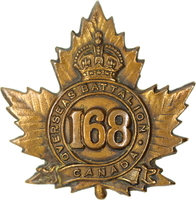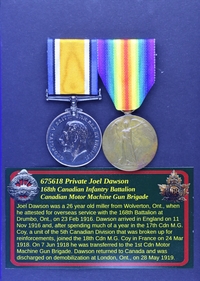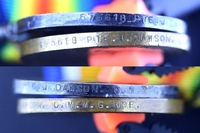
675618 Private Joel Dawson
168th Battalion C.E.F. "Oxford's Own"
1st Canadian Motor Machine Gun Brigade
By: Capt (ret'd) Michael M. O'Leary, CD, The RCR
Joel Dawson was born in Blenheim Township, Oxford County, Ontario, on 19 Sep 1889. Dawson's family, led by parents Spurgeon (24) and Nettie (26), can be found in the 1891 Canadian Census where the family is shown with two children, Robert (3) and Joel (1). By the time of the 1901 Census, a third child has joined the family, younger sister Mildred (7 years of age in 1901). By the 1911 Canadian Census, both Robert and Joel have moved out of the family home.
Dawson was an 18-year-old farmer when he married Laura Jane Balkwill on 11 Nov 1908 at Gobles, Oxford County. Laura was the 17 year old daughter of James and Ruth Balkwill of Wolverton. The Dawsons appear in the 1911 census, Joel, now 21, married to Laura (20) and the couple have a young daughter, Amy (1).
On 23 Feb 1916, Dawson attested for service in the Canadian Expeditionary Force (C.E.F.) with the168th Overseas Battalion at Drumbo, Ont. A 26-year-old miller, Dawson was described on his attestation paper as 5 feet 7 inches tall, weighing 150 pounds, with a 38-inch chest, a medium complexion, brown eyes, and brown hair. His religious denomination was Baptist. Dawson identified his wife, Laura Dawson, Blenheim Township, Oxford, Ont., as his next of kin. On attesting with the 168th Battalion, Dawson was given the regimental number 675618. The 168th Battalion based in Woodstock, Ontario, and the unit began recruiting during the winter of 1915-16 throughout Oxford County. The Battalion sailed for England on 20 Oct 1916 aboard the troop ship S.S. Lapland. The battalion was reduced on 4 Jan 1917 when its remaining personnel were absorbed into the 4th and 6th Reserve Battalions.
Staring in November, 1916, Dawson established a monthly Pay Assignment of $15 to be sent to his wife. As a Private in the C.E.F., Dawson was paid $1.00 per day play an additional ten cents daily field allowance. His pay assignment represented about two-thirds of his monthly pay. Laura Dawson also received $20 monthly Separation Allowance, which had begun in March, 1916. The amount of separation allowance would increase to $25 per month in December, 1917, and to $30 in September, 1918.
The 168th Battalion arrived in England and disembarked at Liverpool on 11 Nov 1916. Dawson was transferred to the 39th Battalion at West Sandling on 5 Dec 1916 and a month later, on 4 Jan 1917, transferred again to the 6th Reserve Battalion.
On 18 Feb 1918, Dawson transferred to the Canadian Machine Gun Depot at Seaford. He was taken on strength of the 17th Machine Gun Company on 7 Mar 1917 and changed units once again on 27 Mar 1917 with a transfer to the 18th Machine Gun Company. Both of these Machine Gun Companies were units of the newly forming 5th Canadian Division. Dawson would serve through 1917 and early 1918 with the 5th Division, but it would not deploy to France before being broken up in February 1918 again to sustain the stream of reinforcements needed by the four divisions in France and Flanders.
The 18th Cdn. M.G. Coy. was organized at Witley on 6 Feb 1917 drawing its first soldiers from the Canadian Machine Gun Depot at Crowborough. The 18th C.M.G.Coy. was designated for the 14th Canadian Infantry Brigade of the 5th Division (which was disbanded at Whitley in February 1918). The Company, with the 17th and 19th C.M.G.Coys., formed 5th Battalion, C.M.G.C., in March 1918 and arrived in France later that month. Once in France, the 18th C.M.G.Coy. was absorbed by 1st Canadian Motor Machine Gun Brigade on 7 June 1918.
On 23 Mar 1918, Dawson embarked in England to cross the Channel to France. He disembarked the following day, entering the theatre of war.
Dawson was struck off the strength of the 18th M.G. Coy. On 7 Jun 1918 on transfer to the 1st Motor Machine Gun Brigade. The 1st Canadian Motor Machine Gun Brigade was organized in Ottawa in August 1914 as Automobile Machine Gun Brigade No.1 under the command of Major R. Brutinel. Mobilized at Ottawa and Valcartier, the unit recruited across the country with the result that about half the unit strength was made up of chauffeurs and mechanics. Vehicles and machine guns were donated by prominent and patriotic citizens. The unit arrived in England in October, 1914, and in France on 17 Jun 1915 where it was attached to 1st Canadian Division and redesignated the 1st Canadian Motor Machine Gun Brigade. Reorganized on 8 June 1918, the Brigade absorbed Borden's Motor Machine Gun Battery and "C" and "D" Batteries of the 18th Cdn.M.G.Coy. At the end of the war, the 1st Cdn.M.G.Bde. returned to Canada and was demobilized in April 1919.
The History of the Canadian Machine Gun Corps, C.E.F., (Logan & Levey, 1919) describes the state of the Motor Machine Gun units in the spring and summer of 1918:
"The 1st C.M.M.G.B. and the Borden, Eaton and Yukon Batteries spent the time between April 10th, and June 8th, 1918, in cleaning and overhauling their fighting Equipment and Transport, in Machine Gun Training, in Infantry and Physical Drill, and on games and sports. On the latter date, the 2nd Canadian Motor Machine Gun Brigade was organised and the Borden, Eaton and Yukon Batteries ceased to be Administrative Units on being absorbed by the 1st and 2nd Canadian Motor Machine Gun Brigades. On June 7th, 1918, the Eaton and Yukon batteries moved from VERDREL to OLHAIN taking over the Billets occupied by the 18th Canadian Machine Gun Company, which moved to VERDREL. On June 13th, the Headquarters and 5 Batteries of the 2nd C.M.M.G.B. concentrated at DIVION.
"The 1st and 2nd Canadian Motor Machine Gun Brigades spent the period June 8th-July 30th in General Machine Gun and Infantry Training, in Overhead, Indirect and Barrage Machine Gun instruction and drill, and in carrying out Tactical Exercises. On July 14th, the 1st C.M.M.G.B. moved from its Camp at VERDREL to Billets in TILLOY-les-HERMAVILLE and on the 15th, the 2nd C.M.M.G.B. moved from DIVION to HERMAVILLE. Both Units remained in these locations until July 30th, 1918, when they proceeded to the FOURTH ARMY Area on the AMIENS Front." (p. 266)
In August 1918 a Mobile Force, composed of the 1st and 2nd Canadian Motor Machine Gun Brigades, the Canadian Corps Cyclist Battalion, and one Section of 6-inch Newton Mortars, was formed to secure the right boundary of the Canadian Corps. This Force was named the Canadian Independent Force and was commanded by the G.O.C. Canadian Machine Gun Corps, Brigadier-General R. Brutinel, C.B., C.M.G., D.S.O. No. 1 Group of the Independent Force consisted of the 1st Canadian Motor Machine Gun Brigade with 5 Motor Machine Gun Batteries (40 Guns), 2 platoons of Cyclists, and 20 motorcyclists.
Throughout the final months of the war, Canada's 100 Days, the Canadian Independent Force worked in cooperation with, and in support of the Divisions of the Canadian Corps. The Canadian Independent Force ended the war working in cooperation with the 6th Canadian Infantry Brigade. South-East of Mons, the Force reached the village of Spiennes but was out of contact withe the enemy when the Armistice took effect.
Dawson was struck off the strength of the 1st C.M.M.G. Bde on transfer to the C.M.G.R. Pool on 20 Feb 1919. The following day, on 21 Feb 1919, he was admitted to No. 9 Canadian Stationary Hospital suffering from V.D.S. sores (venereal disease, syphilis). While he was in hospital, Dawson forfeited his field allowance and was placed under stoppages of pay at the rate of 50 cents per diem while in hospital from 22 Feb 1919 to 10 Mar 1919 (17 days).
After he was discharged from hospital, on 11 Mar 1919, Dawson was taken on the strength of the Canadian General Base Depot (C.G.B.D.) from No. 9 Cdn. Stat. Hosp. From the C.G.B.D., Dawson returned to England, passing through the Cdn. M.G. Depot and transferring on 6 May 1919 to Military District No. 1 Wing, Rhyl, in readiness to return to Canada.
Sailing from Southampton on 18 May 1919 aboard the S.S. Aquitania, Dawson landed at Halifax, N.S., on 25 May 1919. On sailing from England he was taken on the strength of District Depot No. 1 at London, Ont.
Dawson was discharged from the C.E.F. at No. 1 District Depot on 28 May 1919. On discharge, Dawson was eligible to receive a War Service Gratuity of $420. Laura Dawson also received a spousal amount of $180. Cheques were issued to both of them in five installments between May and October 1919.
Dawson and his family appear in the 1921 Canadian Census for Blenheim, Ontario. Joel (31) and Laura (30) are shown with two daughters, Amy (11) and Gladys (9). Dawson's employment is shown in 1921 as store keeper.
For his service in the C.E.F., Dawson was entitled to receive the British War Medal and the Victory Medal. These were despatched to him at Wolverton, Ont., on 27 Dec 1922.
Joel Dawson died in 1966. He is buried in Drumbo Cemetery in Drumbo, Oxford County, Ont. Laura survived him by a decade, she died in 1976 and rests beside Joel.
Pro Patria
Visit a randomly selected page in The O'Leary Collection (or reload for another choice):
- The O'Leary Collection; Medals of The Royal Canadian Regiment.
- Researching Canadian Soldiers of the First World War
- Researching The Royal Canadian Regiment
- The RCR in the First World War
- Badges of The RCR
- The Senior Subaltern
- The Minute Book (blog)
- Rogue Papers
- Tactical Primers
- The Regimental Library
- Battle Honours
- Perpetuation of the CEF
- A Miscellany
- Quotes
- The Frontenac Times
- Site Map
QUICK LINKS
The O'Leary Collection—Medals of The Royal Canadian Regiment
Newest additions:
![]()
![]() SB-12725 Private Henry "Hank" Ard
SB-12725 Private Henry "Hank" Ard ![]()
WIA at Hill 187, Died of Wounds in Japan
![]()
![]() 2355331 Lance Corporal Albert Lorking
2355331 Lance Corporal Albert Lorking
Wounded in action, later a War Amps representative.
![]()
![]() 4334 / 477996 Pte Isaac Hamilton Wilcox
4334 / 477996 Pte Isaac Hamilton Wilcox
Permanent Force, South Africa, and C.E.F.
![]()
![]() 477019 Private Harold Ashcroft
477019 Private Harold Ashcroft
Transferred to the Tunnelers.
![]()
![]() 734231 Private Clark D. Thompson
734231 Private Clark D. Thompson ![]()
The older Thompson brother, killed in action.
![]()
![]() 733849 Private Norman Parker Thompson
733849 Private Norman Parker Thompson
The younger Thompson brother; post-war service in the Special Guard.
![]()
![]()
![]() A305 / 400305 Private Andrew Walker
A305 / 400305 Private Andrew Walker ![]()
"Previously reported Wounded, now Killed in Action."
![]()
![]() 823298 Pte Thomas Patrick Steele, M.M.
823298 Pte Thomas Patrick Steele, M.M. ![]()
… for gallant conduct in the field …
![]()
![]() P13066 Sergeant Harold Thompson
P13066 Sergeant Harold Thompson
Instrumental Soloist for over 20 years of Canadian Army service.
![]()
![]() 9609 / 477728 Private Albert Edward Piper
9609 / 477728 Private Albert Edward Piper
"Arrived from England as a STOWAWAY …"




